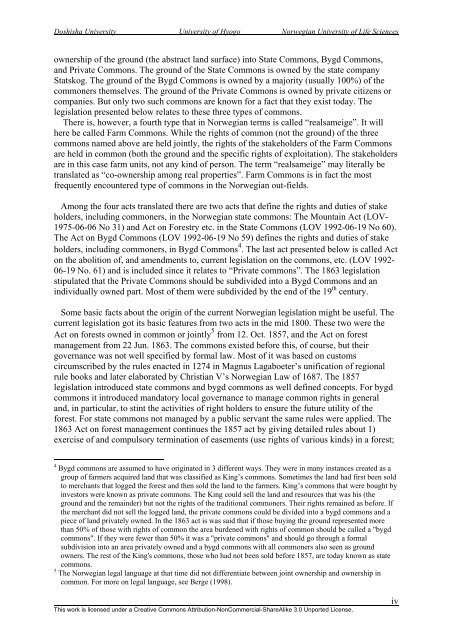(Statsallmenning/ Bygdeallmenning) in Norway. - UMB
(Statsallmenning/ Bygdeallmenning) in Norway. - UMB
(Statsallmenning/ Bygdeallmenning) in Norway. - UMB
You also want an ePaper? Increase the reach of your titles
YUMPU automatically turns print PDFs into web optimized ePapers that Google loves.
Doshisha University University of Hyogo Norwegian University of Life Sciences<br />
ownership of the ground (the abstract land surface) <strong>in</strong>to State Commons, Bygd Commons,<br />
and Private Commons. The ground of the State Commons is owned by the state company<br />
Statskog. The ground of the Bygd Commons is owned by a majority (usually 100%) of the<br />
commoners themselves. The ground of the Private Commons is owned by private citizens or<br />
companies. But only two such commons are known for a fact that they exist today. The<br />
legislation presented below relates to these three types of commons.<br />
There is, however, a fourth type that <strong>in</strong> Norwegian terms is called “realsameige”. It will<br />
here be called Farm Commons. While the rights of common (not the ground) of the three<br />
commons named above are held jo<strong>in</strong>tly, the rights of the stakeholders of the Farm Commons<br />
are held <strong>in</strong> common (both the ground and the specific rights of exploitation). The stakeholders<br />
are <strong>in</strong> this case farm units, not any k<strong>in</strong>d of person. The term “realsameige” may literally be<br />
translated as “co-ownership among real properties”. Farm Commons is <strong>in</strong> fact the most<br />
frequently encountered type of commons <strong>in</strong> the Norwegian out-fields.<br />
Among the four acts translated there are two acts that def<strong>in</strong>e the rights and duties of stake<br />
holders, <strong>in</strong>clud<strong>in</strong>g commoners, <strong>in</strong> the Norwegian state commons: The Mounta<strong>in</strong> Act (LOV-<br />
1975-06-06 No 31) and Act on Forestry etc. <strong>in</strong> the State Commons (LOV 1992-06-19 No 60).<br />
The Act on Bygd Commons (LOV 1992-06-19 No 59) def<strong>in</strong>es the rights and duties of stake<br />
holders, <strong>in</strong>clud<strong>in</strong>g commoners, <strong>in</strong> Bygd Commons 4 . The last act presented below is called Act<br />
on the abolition of, and amendments to, current legislation on the commons, etc. (LOV 1992-<br />
06-19 No. 61) and is <strong>in</strong>cluded s<strong>in</strong>ce it relates to “Private commons”. The 1863 legislation<br />
stipulated that the Private Commons should be subdivided <strong>in</strong>to a Bygd Commons and an<br />
<strong>in</strong>dividually owned part. Most of them were subdivided by the end of the 19 th century.<br />
Some basic facts about the orig<strong>in</strong> of the current Norwegian legislation might be useful. The<br />
current legislation got its basic features from two acts <strong>in</strong> the mid 1800. These two were the<br />
Act on forests owned <strong>in</strong> common or jo<strong>in</strong>tly 5 from 12. Oct. 1857, and the Act on forest<br />
management from 22 Jun. 1863. The commons existed before this, of course, but their<br />
governance was not well specified by formal law. Most of it was based on customs<br />
circumscribed by the rules enacted <strong>in</strong> 1274 <strong>in</strong> Magnus Lagaboeter’s unification of regional<br />
rule books and later elaborated by Christian V’s Norwegian Law of 1687. The 1857<br />
legislation <strong>in</strong>troduced state commons and bygd commons as well def<strong>in</strong>ed concepts. For bygd<br />
commons it <strong>in</strong>troduced mandatory local governance to manage common rights <strong>in</strong> general<br />
and, <strong>in</strong> particular, to st<strong>in</strong>t the activities of right holders to ensure the future utility of the<br />
forest. For state commons not managed by a public servant the same rules were applied. The<br />
1863 Act on forest management cont<strong>in</strong>ues the 1857 act by giv<strong>in</strong>g detailed rules about 1)<br />
exercise of and compulsory term<strong>in</strong>ation of easements (use rights of various k<strong>in</strong>ds) <strong>in</strong> a forest;<br />
4 Bygd commons are assumed to have orig<strong>in</strong>ated <strong>in</strong> 3 different ways. They were <strong>in</strong> many <strong>in</strong>stances created as a<br />
group of farmers acquired land that was classified as K<strong>in</strong>g’s commons. Sometimes the land had first been sold<br />
to merchants that logged the forest and then sold the land to the farmers. K<strong>in</strong>g’s commons that were bought by<br />
<strong>in</strong>vestors were known as private commons. The K<strong>in</strong>g could sell the land and resources that was his (the<br />
ground and the rema<strong>in</strong>der) but not the rights of the traditional commoners. Their rights rema<strong>in</strong>ed as before. If<br />
the merchant did not sell the logged land, the private commons could be divided <strong>in</strong>to a bygd commons and a<br />
piece of land privately owned. In the 1863 act is was said that if those buy<strong>in</strong>g the ground represented more<br />
than 50% of those with rights of common the area burdened with rights of common should be called a "bygd<br />
commons". If they were fewer than 50% it was a "private commons" and should go through a formal<br />
subdivision <strong>in</strong>to an area privately owned and a bygd commons with all commoners also seen as ground<br />
owners. The rest of the K<strong>in</strong>g's commons, those who had not been sold before 1857, are today known as state<br />
commons.<br />
5 The Norwegian legal language at that time did not differentiate between jo<strong>in</strong>t ownership and ownership <strong>in</strong><br />
common. For more on legal language, see Berge (1998).<br />
This work is licensed under a Creative Commons Attribution-NonCommercial-ShareAlike 3.0 Unported License.<br />
iv

















